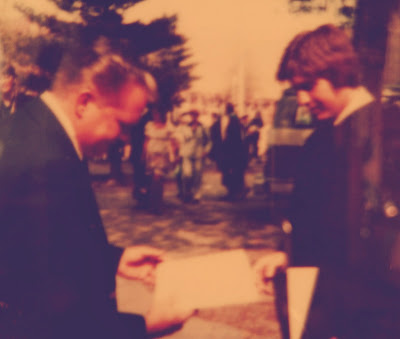 |
| My ghost |
Here are three thoughts today as I leave Verizon (formerly Bell Atlantic, formerly NYNEX) after 34 years to begin a new chapter in my life.
1. No one is truly gone until their name is no longer mentioned.
This is a universal truth, expressed in different ways in different cultures over many centuries by artists and poets and philosophers.
To put it another way, it's our duty to remember those who came before us.
Here are five names of coworkers who have died, and who still have a special place in my heart.
First, from NYNEX, is
Tony Pappas. He is and has always been the soul of Verizon's media relations department.
 |
| Tony Pappas |
Tony was one of my first bosses. He was a legendary New York City PR executive who was a trusted confidante of journalists like Jimmy Breslin, Steve Dunleavy (who coincidentally died just this week), Pete Hamill, Larry Sutton and Verizon's own Steve Marcus. Tony cannot be described in a few words. If you're a movie aficionado, as Tony was, think Peter O'Toole in "My Favorite Year."
Tony lived a long and happy life. He passed away a few months ago, and I attended services surrounded by his family at a graveside in Rutherford, NJ, where he's buried near the poet William Carlos Williams.
This is just to say how appropriate that is.
On a more tragic and somber note, I want to mention the names of contemporaries who all died much too young.
 |
| Robin Flowers |
Robin Flowers was my great friend at NYNEX. I lost track of him when he became a vice president at AT&T, then heard the sad news that he had died of multiple sclerosis in 2012.
A big man with a booming laugh, we did our share of drinking together when we were very young. But, fortunately, we also had colleagues who made up for all the brain cells we may have destroyed.
One was
Jamie DePeau, an incredible spirit who died of cancer in 2016. She was the smartest of us all.
 |
| Jamie DePeau |
Jamie's wildly successful post-NYNEX second act – as a senior marketing VP for TIAA-CREF and then as CMO for Lincoln Financial – inspires me today as I embark on my own new journey.
At Jamie's memorial service, I marveled at the outpouring of love and affection among family, friends and coworkers that overflowed a church that morning in Ridgewood, NJ.
The fourth name, from Bell Atlantic, is
Jeff Gluck. He died of ALS in 2012, leaving behind a wonderful family, including still-young children.
Jeff was my tech guru. We shared a love of software applications and gadgets. My fondest memory of him is one morning in the early 1990s, after he installed one of the first browsers to view sites on something called the World Wide Web.
 |
| Jeff Gluck |
A group of us huddled around Jeff at offices at 1095 Ave. of the Americas in New York, as he taught us about the Internet. "Where would you like to go?" Jeff asked excitedly. "I can take you anywhere in the world from this keyboard."
Our colleague Carol Fessler said, "I'd like to go to The Louvre!"
So Jeff typed a few keystrokes – and as the page loaded we realized unexpectedly, embarrassingly, that we were arriving at a site selling pornography. That truly was an appropriate introduction to our brave new world.
The fifth name, from Verizon, is
Joellen Brown.
 |
| Joellen Brown |
We all mourned her sudden, accidental death earlier this year. Joellen was a kind and thoughtful editor, and she wrote speeches for CEOs Ray Smith, Chuck Lee, Ivan Seidenberg and Lowell McAdam, retiring before the Hans Vestberg era began.
This past April, at another memorial service in another town, I again witnessed a room overflowing with love and affection for a life well-lived. Current and former Verizon colleagues traveled from all over the country – from Texas and West Virginia and Florida – to pay their respects and celebrate Joellen's life.
The most meaningful personal tribute I've received in my career was written in a card a dear friend gave me before the going-away party for a group of us last night. She wrote that Joellen told her when they first started working together that "if you can't find me, go find Varettoni..."
I hope I never let you down, Joellen.
2. I will never forget the Verizon PR team, and I will always mention their names with respect and love.
I'm awed by how talented, hard-working and creative the Verizon PR team is.
Here's our secret: we know that as important as the work itself is, how the work gets done is just as important. The team has always been at its best when we've shown up for each other, and when we've known we could depend on each other.
The work itself? Verizon is a company that connects people and helps them communicate. It deploys and enables new and life-changing technologies and applications.
I truly believe that Verizon is building a better future for those who will come after us.
As a company spokesperson for most of my career, that belief has made my job very easy. All the journalists I've worked with know that everyone they talk to has an agenda.
My agenda has been transparent: to be an effective advocate for all the people who make up the heart and soul of Verizon.
To all the Verizon customer service representatives, field technicians and engineers; all the Verizon Wireless store employees, executive assistants and office managers, and sales and support people; all the IT, technology and finance professionals: I admire your talents and I appreciate how difficult your jobs are.
Mine was a privileged position. I hope I always honored those I represented. Whenever I spoke on behalf of Verizon, I always knew I was standing on the shoulders of giants.
Speaking of which...
3. Here's to Robert J. Varettoni.
 |
| Robert J. Varettoni |
My Dad, who died in 2005, also worked for Verizon for 34 years.
He started in sales at New York Telephone and eventually became a customer service director at NYNEX, then Verizon. He got his job at "the phone company" in 1956 through the influence of his buddy on the U.S.S. Midway and in the Navy Reserve, John A. Coleman, whose own father had been chairman of the NYSE.
Dad claimed he had no influence in getting me a job here in 1985. I find that hard to believe.
Also hard to believe (and including the few years our careers overlapped): tomorrow morning, for the first time in 63 years, there will be no "Bob Varettoni" working at Verizon.
---------
Finally, here's something we all can believe in, no matter where we work. It's something Dad discovered through his colleagues
Vinnie Merrill,
Eileen Vodola and
Ed Small:
There are people working beside you today who you will love and revere for your entire life.
So ask yourself: How are you showing up for them?
Our time together is really very short and unpredictable and precious.
How will people remember your name?
---
About the top photo: Dad's office used to be at 1095 Ave. of the Americas, where Verizon currently has its NYC headquarters. I have fond memories of visiting Dad there when I was a boy, so I worked from "1095" one day this week. This is a reflection of myself waiting for the elevator home.





































